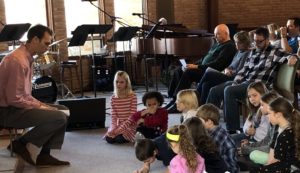Each part of a church service has a special significance, but the children’s sermon is one of my favorites.
 On a recent Sunday, our pastor was doing a good job describing Jesus as the Light of the world when one of the children, age four, raised his hand. Having just heard all about the Light, he felt it was important to add something. “My favorite color is dark.”
On a recent Sunday, our pastor was doing a good job describing Jesus as the Light of the world when one of the children, age four, raised his hand. Having just heard all about the Light, he felt it was important to add something. “My favorite color is dark.”
Most pastors are good at handling this kind of spontaneity, especially when it comes from a child. After acknowledging the comment, Pastor Jay smoothly moved his words from darkness back to light.
That afternoon at home I was still chuckling over the morning’s comment when I remembered our first grandchild, Skylar, who would have appreciated that unprompted addition to the children’s sermon.
 When she was only three (left), her Auntie Weezi asked her a question most kids love to answer. “Sky, what’s your favorite color?”
When she was only three (left), her Auntie Weezi asked her a question most kids love to answer. “Sky, what’s your favorite color?”
Skylar answered without even looking up. “Black.”
Most little girls are into pink and purple, but each child is allowed to have their own favorite. Skylar’s unusual choice gave us all a good giggle that day.
My next-door-neighbor, Linda, told me that when she was a child walking home in the dark, she was never afraid. Instead she looked into the inky blackness around her and thought about the interesting things that might be hidden in the darkness – good things. She probably would have nodded in agreement to the favorites of dark and black.
Some of my widowed friends (including me) have experienced the opposite perspective on darkness. After becoming widows, we might find our imaginations allowing fear to creep in, uninvited. This is when we need to turn to God to get his opinion. He created darkness as well as light and surely isn’t biased against either one.
 His explanation to me has been that the black of night is not the problem. Rather it’s the fear. And fear is never, he says, from him. It’s a tool of the devil who uses it to knock us off balance emotionally. God tells us there’s no darkness in him at all (1 John 1:5) and that he’s not afraid of it. As a matter of fact, darkness looks light to him (Psalm 139:12). The only darkness that should concern us is spiritual darkness – not knowing the truth of salvation.
His explanation to me has been that the black of night is not the problem. Rather it’s the fear. And fear is never, he says, from him. It’s a tool of the devil who uses it to knock us off balance emotionally. God tells us there’s no darkness in him at all (1 John 1:5) and that he’s not afraid of it. As a matter of fact, darkness looks light to him (Psalm 139:12). The only darkness that should concern us is spiritual darkness – not knowing the truth of salvation.
As for fearing the black of night, it might help to spend more time hanging around those youngsters who love both black and dark.
“For you are my lamp, O Lord, and the Lord will lighten my darkness.” (2 Samuel 22:29)


